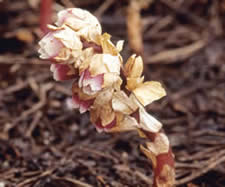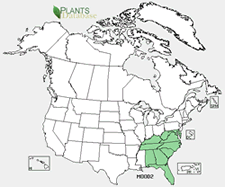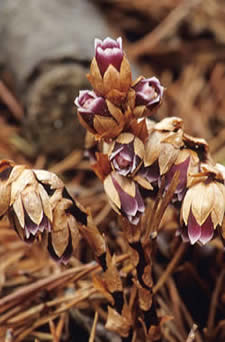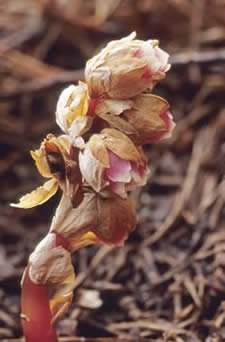USDA Forest Service Celebrating Wildflowers
|
|
|
Thieves from the Heath - Mycotrophic WildflowersMonotropsis odorata – Sweet PinesapSweet Pinesap is a rare, herbaceous perennial wildflower with a geographic distribution in the southeastern United States. It occurs more often in North Carolina and Virginia and rarer in the remaining states. Monotropsis odorata (Monotropsis – like Montropa from its physical appearance being similar to the genus Monotropa; odorata – odor from its strong odor of violets; sometimes being smelled before being sighted). Monotropsis odorata attains a height of 5 to 10 centimeters. The plant is fleshy. The leaves are scale like. The flower stalk (peduncle) is purplish brown. The inflorescence is a nodding cluster of flowers at the top of the flower stalk. The flowers are pink or yellowish and pubescent inside. Upon emerging from the ground, the flowers are pendant. As the anthers and stigma mature, the flowers are spreading to all most perpendicular to the stem. The fruit is a capsule. As the capsule matures, the flowers become erect. Once ripened, seed is released through slits that open from the tip to the base of the capsules. The plant is persistent after the seeds have dispersed. Monotropsis odorata flowers in mid to late spring. It is found in mature, moist, shaded, rich hardwood forests. Conservation ConcernMonotropsis odorata is listed as threatened in Kentucky and Tennessee; endangered in Florida and Maryland. It is ranked G3, vulnerable by NatureServe. |
|
| NOTE: PDF format links require the Adobe Acrobat Reader to view. | |
| top | Disclaimers | FOIA | Privacy Policy | Quality of Information | Photo Credits & Use |
Location: http://www.fs.fed.us/wildflowers/interesting/mycotrophic/monotropsis_odorata.shtml
Last modified: Monday, 02-Mar-2009 16:18:33 EST












